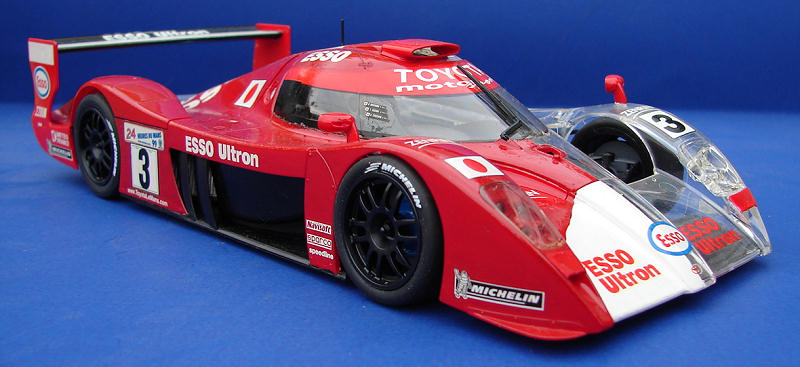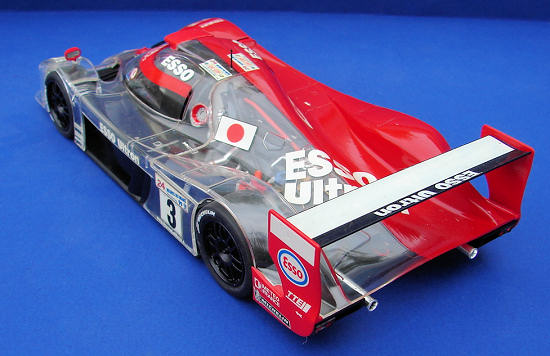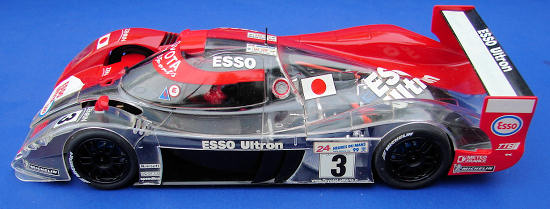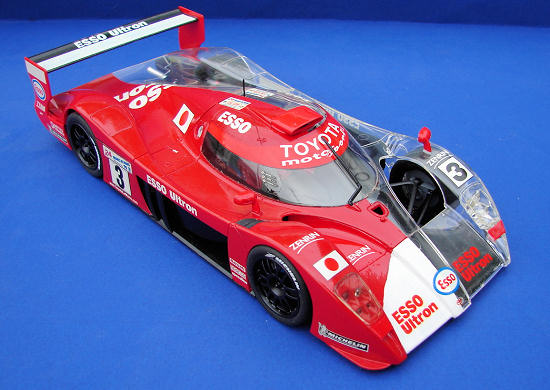
| KIT #: | 222 |
| PRICE: | $35.00 or so MSRP |
| DECALS: | One race, two sponsor versions |
| REVIEWER: | Mark Hiott |
| NOTES: | Clear view edition |

| HISTORY |
Following the
end of the Group C era around 1994,
Toyota decided
to alter its plans in sports
car racing by moving to the production-based GT classes for 1995. Toyota
announced they would skip the 1997 24 Hours of Le Mans to be able to develop
their new GT car for 1998.
Toyota Team
Europe ( they
originally used on their Group C cars, the Toyota R36V, 3.6 litre Twin-Turbo V8.
they
originally used on their Group C cars, the Toyota R36V, 3.6 litre Twin-Turbo V8.
Introduced in
time for Le Mans in 1998, the GT-One first appeared at the official testing days
for the race held in May. Three GT-Ones appeared, setting the 2nd, 5th, and 10th
best times, easily beating out custom built prototypes which were meant to be
the superior class. For the race week itself, all three cars performed admirably
in qualifying by continuing their quick pace, qualifying 2nd, 7th, and 8th,
being beaten only by their GT class competitor, Mercedes-Benz.
Following the
success of the GT1 class as a whole over the Le Mans prototypes, the
Toyota began
an extensive testing program, including a long distance test at Spa-Francorchamps
soon after a snowfall. In the official testing session at Le Mans, the GT-Ones
were again fast, taking the 1st, 3rd, and 5th fastest lap times. This pace
continued
 in
qualifying for the race, as the three GT-Ones took 1st, 2nd, and 8th positions.
The lone GT-One would come home 2nd overall, one lap behind the winning BMW. As
a consolation prize, the GT-One would win the GTP class, although it was the
only car in the class to actually finish.
in
qualifying for the race, as the three GT-Ones took 1st, 2nd, and 8th positions.
The lone GT-One would come home 2nd overall, one lap behind the winning BMW. As
a consolation prize, the GT-One would win the GTP class, although it was the
only car in the class to actually finish.
The GT-One
would race only once more, a single entrant appearing in the 1999 Le Mans Fuji
1000km. Although the race mostly consisted of Japanese teams, thus leaving out
most of the manufacturers that had competed at Le Mans, Toyota still had to
compete against rival Nissan, who also entered their R391. In the end the GT-One
would fall short once again, finishing 2nd and only one lap behind the winning
R391.
The GT-One
program would not be continued into 2000, Toyota instead turning
| THE KIT |
 As
anyone who has built one knows, Tamiya makes really nice car kits. This one is
no different. The body is nicely molded in clear plastic with no blemishes or
cracks. The rest of the parts are molded in white, black and silver plastic. A
very nice set of rubber tires are included as well as tire emblems.
As
anyone who has built one knows, Tamiya makes really nice car kits. This one is
no different. The body is nicely molded in clear plastic with no blemishes or
cracks. The rest of the parts are molded in white, black and silver plastic. A
very nice set of rubber tires are included as well as tire emblems.
Decals are included for one race, but with different sponsor decals for two versions of the car. A nice touch is the included paint masks for the white nose. Instructions are the typical nicely done Tamiya and include color call-outs
| CONSTRUCTION |
 There
were really no problems with this kit. Construction begins with the engine and
rear suspension. The turbos and exhausts are a bit of a handful and some test
fitting will be needed here. The front tub is then assembled. The kit includes a
driver figure that looks really nice. There is a separate instruction sheet for
it, so you have to decide if you're gonna use it as it needs to be installed in
the chassis before part #A27 in step 8. The cockpit and engine are joined to the
bottom tray in step 9. Care should be taken when assembling the body. There are
several parts that are added that are not clear and doing it without making a
mess of the clear body can be a pain.
There
were really no problems with this kit. Construction begins with the engine and
rear suspension. The turbos and exhausts are a bit of a handful and some test
fitting will be needed here. The front tub is then assembled. The kit includes a
driver figure that looks really nice. There is a separate instruction sheet for
it, so you have to decide if you're gonna use it as it needs to be installed in
the chassis before part #A27 in step 8. The cockpit and engine are joined to the
bottom tray in step 9. Care should be taken when assembling the body. There are
several parts that are added that are not clear and doing it without making a
mess of the clear body can be a pain.
| COLORS & MARKINGS |
Most
of the chassis parts need to be painted before assembly. The suspension is
particularly difficult to paint with all the tiny details. I followed the
call-outs in the instruction sheet for the most part.
Seeing how this was the clear version, I decided I was gonna paint it up
half-n-half. I masked off the left side and sprayed the
 body
with Tamiya bright red in the can. BAD IDEA! The Tamiya paint attacked the clear
plastic and I was unable to save the body. So... I had to buy another kit just
to rob the body parts out of it!
body
with Tamiya bright red in the can. BAD IDEA! The Tamiya paint attacked the clear
plastic and I was unable to save the body. So... I had to buy another kit just
to rob the body parts out of it!
This
time, after masking, I sprayed the body with Testors MM bright red and had no
further problems. After applying the red I masked it off and sprayed Testors
Bright White on the nose. A bit of touch-up was required around the area where
the red and white meet. Various parts that were molded in color also shot in
red: mirrors, rear wing supports and roof intake. The clear parts did have a
slightly darker hue to the red paint then the parts molded in white. I suppose a
primer on the body might have helped.
The decals went on with no trouble whether it was on the clear half or the painted half. The white decals are also thick enough that I didn't notice any change going from clear to red. The rear wing was left unpainted and the decals applied directly to the black plastic.
| CONCLUSIONS |
I
made it a harder build then it would be OOB, but I like the overall effect of
the half clear body. It has nice detail but I think Tamiya could have added a
bit more with the clear body. It could benefit from a bit of added detail if one
so desires. The clear body makes it hard to attach parts without making a mess
of things, but that's a necessary evil if you want the clear body.
For
anyone who likes these car like I do, this kit is a must have.
| REFERENCES |
Photos of the net
Wikipedia
Mark Hiott
August 2010
If you would like your product reviewed fairly and quickly, please contact me or see other details in the Note to Contributors.